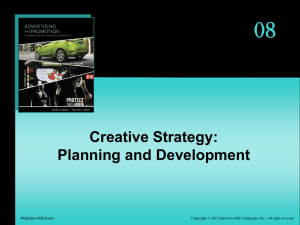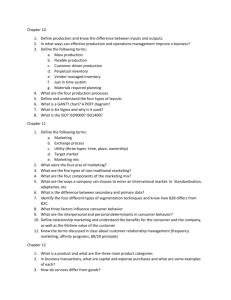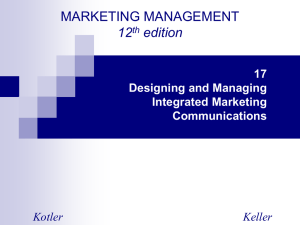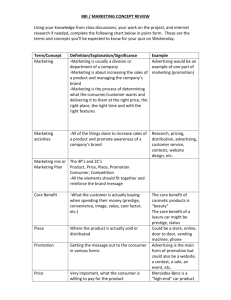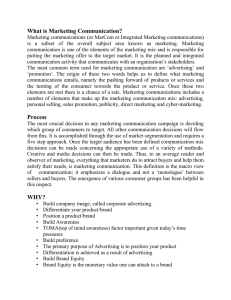Document
advertisement
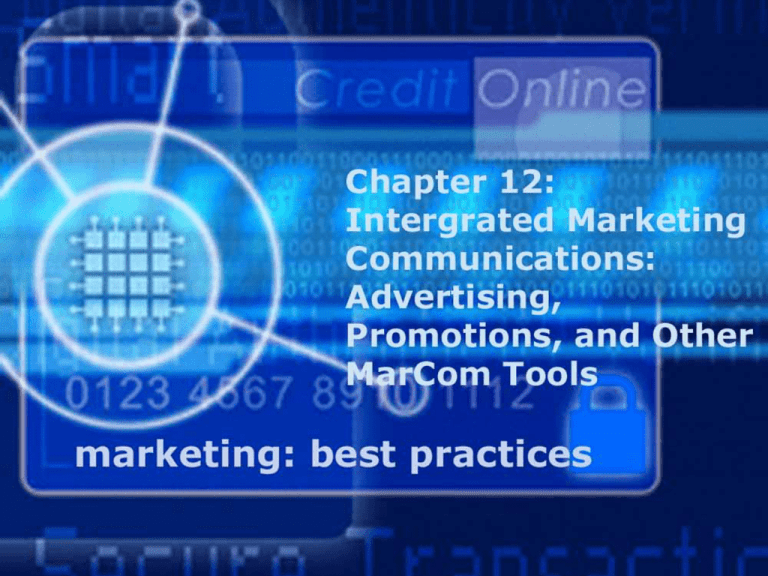
• Integrated Marketing Communications: Advertising, Promotions. And Other MarCom Tools LEARNING OBJECTIVES Appreciate the variety marketing • Appreciate the of variety of marketing communications tools, and howand they work communications tools, how they togetherwork to accomplish communication together to accomplish objectives communication objectives. • Understand the nature, importance, and Understand the nature, importance, and features of integrated marketing featurescommunications. of integrated marketing communications • Describe the concept of brand-equity enhancement and the role of marketing communications in facilitating this Describe the concept of brand-equity objective. enhancement and the role of marketing communications in facilitating this objective LEARNING OBJECTIVES Comprehend the factors that determine how • Comprehend the factors that determine differenthow marketing communications elements different marketing communications are effectively combined elements are effectively combined. • Discuss the primary decision spheres Discuss the primary decisions spheres involved involved managing the marketing in managing the in marketing communications process communications process. • Know the major activities involved in formulating advertising strategy. Know the major activities involved in formulating advertising strategy LEARNING OBJECTIVES Recognize the role of sales promotion. • Recognize the role of sales promotion, Appreciate the reasons why this form of form of appreciate the reasons why this marketing communication has experienced marketing communication has rapid growth, and know the tasks that can the experienced rapid growth, and it know and cannot accomplish tasks that it can and cannot accomplish. • Evaluate theand nature and function Evaluate the nature function of publicof public relations. relations • Appreciate sponsorship marketing and the sponsorship practices of event marketing and Appreciate marketing and the cause-related marketing practices of event marketing and cause-related marketing LEARNING OBJECTIVES • Understand the role, importance, and growth of point-of-purchase communications. Understand the role, importance, and growth of point-of-purchase communications THE TOOLS OF MARKETING COMMUNICATIONS Advertising Personal Selling Publicity MarCom Mix Sales Promotion P-O-P Sponsorship Personal Selling • Person-to-person communication in which a seller informs and educates prospective customers and attempts to influence their purchase choices. THE TOOLS OF MARKETING COMMUNICATIONS Advertising Personal Selling Publicity MarCom Mix Sales Promotion P-O-P Sponsorship Advertising • Nonpersonal communication that is paid for by an identified sponsor and involves either mass communication and other media or direct-to-consumer communication via direct mail. THE TOOLS OF MARKETING COMMUNICATIONS Advertising Personal Selling Publicity MarCom Mix Sales Promotion P-O-P Sponsorship Publicity or Public Relations • Non-personal communication to a mass audience that is not directly paid for by the company. THE TOOLS OF MARKETING COMMUNICATIONS Advertising Personal Selling Publicity MarCom Mix Sales Promotion P-O-P Sponsorship Sales Promotion • All the marketing activities that attempt to promote immediate sales of a product. THE TOOLS OF MARKETING COMMUNICATIONS Advertising Personal Selling Publicity MarCom Mix Sales Promotion P-O-P Sponsorship Sponsorship • The practice of promoting the interests of a company and its brands by associating the company with a specific event. THE TOOLS OF MARKETING COMMUNICATIONS Advertising Personal Selling Publicity MarCom Mix Sales Promotion P-O-P Sponsorship Point-of-Purchase (P-O-P) • Includes all signage (displays, posters, signs, shelf cards, and other visual materials) designed to influence buying decisions at the point of sale. KEY PARTICIPANTS IN MARKETING COMMUNICATIONS • Integrated Marketing Communication (IMC) A system of managing and integrating marketing communication elements with the result that all elements adhere to the same message Advertising Personal Selling Publicity MarCom Integrated Marketing Communications Sales Promotion P-O-P Sponsorship Key Aspects of Integrated Marketing Communications Starts with the Customer • Requires careful study of customers’ communication usage pattern and information needs • Communication media (contact points) is dictated by the customer’s needs and behavior • Involves an outside-in approach to decision making Key Aspects of Integrated Marketing Communications Use Any Form of Relevant Contact • Use all forms of communication and all sources of contact • Communication media (contact points) is dictated by the customer’s needs and behavior • Involves utilization of communication outlets that are appropriate for reaching the target audience Key Aspects of Integrated Marketing Communications Achieve Synergy • Another key aspect of IMC is the need for synergy • All communication elements should convey the same, unified message, otherwise consumers will be confused Key Aspects of Integrated Marketing Communications Build Relationships • Successful marketing requires building a relationship between the brand and the customer • Entails repeat purchase and loyalty • More profitable to build and maintain relationships than to continuously search for new customers Key Aspects of Integrated Marketing Communications Affect Behavior • More than awareness or attitude changes but must include behavioral changes • Moving people to action Key Changes in MarCom Practice Resulting from the IMC Thrust 1. Reduced Dependence in Mass-Media Advertising 2. Increased reliance on highly targeted communications methods 3. Expanded efforts to assess return on investment THE MARCOM CHALLENGE: ENHANCE BRAND EQUITY Brand Recognition • Figure 12.1 Brand Awareness Brand Recall Attributes Types of Brand Associations Benefits Favorability, Strength, and Uniqueness of Brand Association Overall Evaluation (Attitude) Brand Knowledge Brand Image Brand Equity • A brand possesses equity to the extent that consumers are familiar with the brand and have stored in memory favorable, strong, and unique brand associations Brand Awareness Brand Image Brand Awareness • Whether a brand name comes to mind when consumers think about a particular product category and the ease with which the name is evoked Brand Awareness Brand Image Brand Image • The associations that come to mind when contemplating a particular brand • Brand association - the particular thoughts and images that a consumer has about a brand Brand Awareness Brand Image DETERMINING AN APPROPRIATE MIX OF IMC TOOLS Market Objectives Nature of the Product Life-cycle Stage Competitive Actions Budget Push vs. Pull • Who is the intended market? • Business-tobusiness market or consumer market? • Understanding of the product’s target market DETERMINING AN APPROPRIATE MIX OF IMC TOOLS Market Objectives Nature of the Product Life-cycle Stage Competitive Actions Budget Push vs. Pull • What are the objectives? • Do we want to create product category wants or brand preference? The Hierarchy of Effects Purchase • Insert Figure 12.2 Purchase Intention Attitude Beliefs/Knowledge Awareness Unawareness DETERMINING AN APPROPRIATE MIX OF IMC TOOLS Market Objectives Nature of the Product Life-cycle Stage Competitive Actions Budget Push vs. Pull • What is the nature of the product? • Business-tobusiness products versus consumer goods DETERMINING AN APPROPRIATE MIX OF IMC TOOLS Market Objectives Nature of the Product Life-cycle Stage Competitive Actions Budget Push vs. Pull • What is the product life-cycle stage? • New product versus a mature product DETERMINING AN APPROPRIATE MIX OF IMC TOOLS Market Objectives Nature of the Product Life-cycle Stage Competitive Actions Budget Push vs. Pull • What are competitors doing? • Does the competition allow trade allowances and, if so, how large? DETERMINING AN APPROPRIATE MIX OF IMC TOOLS Market Objectives Nature of the Product Life-cycle Stage Competitive Actions Budget Push vs. Pull • What is the available budget for promotion? • Do we emphasize personal selling or mass advertising? DETERMINING AN APPROPRIATE MIX OF IMC TOOLS Market Objectives Nature of the Product Life-cycle Stage Competitive Actions Budget Push vs. Pull • Will a push or pull strategy be most effective? • Trade allowances and personal selling versus advertising and sales promotion • Combination of push and pull technique Push vs. Pull Strategy Push Strategy VS Pull Strategy Push Strategy • Utilizes aggressive trade allowances and personal selling to obtain wholesaler and retailer distribution • The product is pushed through the channel Pull Strategy • Encourages consumer demand for the product to obtain distribution • Use of heavy advertising and high value coupons MANAGING THE MARCOM PROCESS Selecting Target Market Establishing Objectives Formulating a Positioning Strategy Setting Budget Formulating and Implementing Message and Media Strategies Evaluating Program Effectiveness MANAGING THE MARCOM PROCESS Selecting Target Market • Allows marketing communicators to more precisely deliver messages to the target group • Attempts to avoid wasting money outside the target market • Identify potential target markets in terms of a combination of characteristics that will cause these consumers to act in a similar fashion (demographics, lifestyles and so on) MANAGING THE MARCOM PROCESS Establishing Objectives • Objectives must fit within the company’s overall corporate and marketing objectives • Must also be realistic and stated in quantitative terms with the amount of projected change and the time duration specified MANAGING THE MARCOM PROCESS Formulating a Positioning Strategy • Essential activity in developing successful MarCom programs • Clear statement defining to whom a brand should be targeted, what should be said about the brand, and what media and message vehicles should be used MANAGING THE MARCOM PROCESS Setting Budget • Top-down budgeting (TD): senior management decides how much each subunits receives • Bottom-up budgeting (BU): managers of subunits determine how much is needed and the amounts are then combined to establish the total budget • Bottom-up/top-down (BUTD) • Top-down/bottom-up (TDBU) • BUTD process is the most frequently used MANAGING THE MARCOM PROCESS Formulating and Implementing Message and Media Strategies • Make a decision regarding the message to be communicated and the media within which the message will be sent • Many different alternatives of media are available and each has a unique rate of effectiveness as well as cost MANAGING THE MARCOM PROCESS Evaluating Program Effectiveness • Evaluation information will be critical in creating future programs and taking corrective action when necessary • Advertising is more difficult to measure • Communication outcomes: changes in consumers’ awareness of the advertised brand, knowledge of copy points, or attitudes toward the brand (assess advertising effectiveness) ADVERTISING • Advertising adds value to brand by influencing consumers’ perception • Effective advertising can lead to increased market share and greater profitability • U.S., the biggest advertising spender in the world ADVERTISING STRATEGY Budgeting Establishing the Brand Positioning Objective Setting Assessing Advertising Effectiveness Creating Advertising Messages Selecting Advertising Media ADVERTISING STRATEGY Objective Setting • Reasons for setting advertising objectives Make top management to agree upon the course of advertising Guide the budgeting, message creating, and media selection Provide standards against which results can be measured ADVERTISING STRATEGY Budgeting • The most difficult advertising decision because it is hard to determine precisely how effective advertising has been or might be in the future • The sales-response to advertising is influenced by a multitude of factors Budgeting for Advertising Percent of Sales Objective &Task • Promotional budget set as a percentage of past or anticipated sales Budgeting for Advertising Percent of Sales Objectives &Task • Objectives specified • Promotional elements identified • Budget is determined by accumulating anticipated costs among the various promotional elements ADVERTISING STRATEGY Establishing the Brand Positioning • Establishing how the brand is to be thought of by members of the target market and how the brand is to be perceived relative to competitive brands in the product category ADVERTISING STRATEGY Creating Advertising Messages • Advertisers use a vast array of techniques to present their brands in the most favorable light and persuade customers to contemplate purchasing these brands Creating Advertising Messages • Informational ads Creating Advertising Messages • Humorous executions Creating Advertising Messages • Sex appeals Creating Advertising Messages • Sex appeals Creating Advertising Messages • Celebrity endorsements Creating Advertising Messages • Emotional appeals Creating Advertising Messages • Using animation Creating Effective Messages • • • • Extends from sound marketing strategy Takes the consumer’s view Persuasive Finds a unique way to break through competitive clutter • Never promises more than it can deliver • Prevents the creative idea from overwhelming the strategy Creative Campaigns • Absolut Creative Campaigns • Absolut Creative Campaigns • Absolut Creative Campaigns • Absolut Creative Campaigns • Milk Creative Campaigns • Milk Creative Campaigns • Milk Creative Campaigns • Milk Creative Campaigns • Insert Figure 12.5 ADVERTISING STRATEGY Selecting Advertising Media • Outstanding message execution is to no avail unless the message is delivered to the right customers at the right time, and with sufficient frequency Selecting Advertising Media Selection of Target Audience Specification of Media Objectives Selection of Media Purchase of Media Selecting Advertising Media Selection of Target Audience • Must be clearly pinpointed • Based on geographic factors, demographics, product-usage concerns, psychographics Selecting Advertising Media Specification of Media Objectives • • • • Reach Frequency Continuity Cost Selecting Advertising Media Selection of Media • • • • • Television Radio Magazines Newspapers Internet Selecting Advertising Media • Insert Figure 12.6 Selecting Advertising Media Purchase of Media Cost ___________ CPM= Audience Size GRP=Reach*Frequency CPM Match Target Image ... Overall Magazine1 Magazine2 Magazine3 ... ... Magazine N • • Cost per thousand (CPM) Gross rating points (GRP) ADVERTISING STRATEGY Assessing Advertising Effectiveness • Measure magazine readership Simmons Market Research Bureau(SMRB) and MediaMark Research, Inc. (MRI) • Measure television audience size Nielsen, and Arbitron • Others Starch Readership Service, Burke Day-After Recall Direct Advertising • Database Marketing Offers Addressability Measurability Flexibility Accountability SALES PROMOTION • The use of any incentive by a manufacturer to induce the trade (wholesalers and retailers) or consumers to buy a brand and to encourage the sales force to aggressively sell it Factors Giving Rise to the Growth of Sales Promotion • Balance of power transfer • Increased brand parity and price sensitivity • Reduced brand loyalty • Splintering of the mass market & reduced media effectiveness • Short-term orientation & corporate reward structure • Trade & consumer responsiveness Sales Promotion’s Capabilities • Facilitate the introduction of new products • Obtain trial purchases • Stimulate sales force enthusiasm • Invigorate sales of a mature brand • Increase on- and off-shelf merchandising space Sales Promotion’s Capabilities • Neutralizing competitive advertising • Encouraging repeat purchases • Increase brand usage by loading consumers • Preempting competition by leading consumers • Reinforcing advertising Sales Promotion: Roles and Objectives • • • • • • • • • Introduce new or revised products Increase distribution Build retail inventories Maintain shelf space Obtain display space Reduce excess inventory Induce cooperative advertising Counter competition Sell more to final consumers PUBLIC RELATIONS Proactive MPR • Dictated by a company’s marketing objectives • Offensively oriented • Opportunity-seeking rather than problem-solving • Another tool for promotion of company’s products and services PUBLIC RELATIONS Reactive MPR • Undertaken as a result of external pressures • Deals with changes that have negative consequences • Attempts to repair a company’s reputation, prevent market erosion, and regain lost sales SPONSORSHIP MARKETING • Avoid the clutter • Help companies respond to consumers’ changing media habits • Help companies gain the approval of various constituencies • Enable marketers to target their communication and promotional efforts to specific geographic regions and/or to specific lifestyle groups SPONSORSHIP MARKETING Event Marketing • Form of a brand promotion that ties a brand to a meaningful cultural, social, athletic, or other type of highinterest public activity • Separate from advertising, sales promotion, point-of-purchase merchandising, or public relations SPONSORSHIP MARKETING Cause-Related Marketing • Narrow aspect of overall sponsorship • Combination of PR, sales promotion and corporate philanthropy • Linked to consumers’ engaging in revenue-producing exchanges with the firm SPONSORSHIP MARKETING Cause-Related Marketing • Stride Rite POINT-OF-PURCHASE COMMUNICATIONS Consumers Retailers Manufacturers • P-O-P delivers useful information and simplifies the shopping process by setting products apart from similar items POINT-OF-PURCHASE COMMUNICATIONS Retailers Consumers Manufacturers • Increased sales • Enables retailers to better organize shelf space and improve inventory control, volume, and profitability POINT-OF-PURCHASE COMMUNICATIONS Manufacturers Consumers Retailers • Calls attention to special offers and helps stimulate impulse purchasing • Serves to complement the job already performed by advertising before the consumer enters a store Supplemental Material Communication Process Message Encoding Source Channel Receiver Noise Decoding Feedback Communication Process Message Channel Encoding Receiver Decoding Noise Source • The marketer • The sender of the message Feedback Communication Process Message Encoding Source Channel Receiver Decoding Noise Feedback • Designing of advertisements, sales presentations, P-O-P displays, etc. • Translation of the message into symbolic form Communication Process Message Channel Encoding Receiver Decoding Noise Source Feedback • Actual advertisement that contains the intended message • Symbolic expression of the sender’s thoughts Communication Process Message Channel Encoding Receiver Decoding Noise Source Feedback • Television, radio, print media, telephone, direct mail, etc. • Path through which the message moves to get to the receiver Communication Process Message Channel Encoding Receiver Decoding Noise Source Feedback • Person or groups of persons for whom the message is intended Communication Process Message Channel Encoding Noise Source Receiver Decoding Feedback • Process receiver uses to interpret the meaning of the message Communication Process Message Channel Encoding Receiver Decoding Noise Source Feedback • Marketing research, market share changes, sales reports • Attitude changes, purchase or non-purchase • Gauge of effectiveness of communication techniques Communication Process Message Channel Encoding Noise Source Receiver Decoding Feedback • Interference at some stage in communications process • Competitive promotional messages • Misinterpretation of message or wrong receiver Functions Of Advertising Inform Persuade Remind Add Value Assist Other Efforts • Makes consumers aware of new products • Informs them about specific brands • Educates them about particular product features & benefits Functions Of Advertising Inform Persuade Remind Add Value Assist Other Efforts • Persuade customers to try new products, brands & services • Create demand for entire product category • Build secondary demand Functions Of Advertising Inform Persuade Remind Add Value Assist Other Efforts • Keeps company’s brand fresh in consumer’s memory • Create top-of-mind awareness Functions Of Advertising Inform Persuade Remind Add Value Assist Other Efforts • Innovation • Improving quality • Altering consumer perceptions Functions Of Advertising Inform Persuade Remind Add Value Assist Other Efforts • Delivering sales promotions • Assist sales representatives • Pre-sell products • Provide salespeople with valuable introduction Communication Objectives Build Products Wants Create Brand Awareness Enhance Attributes Intentions Facilitate Purchase Communication Objectives • Marketers must first build product category wants or primary demand Build Products Wants Create Brand Awareness Enhance Attributes/Intentions Facilitate Purchase Communication Objectives • After a product category is established, marketers attempt to create secondary demand for their specific brand Build Products Wants Create Brand Awareness Enhance Attributes/Intentions Facilitate Purchase Communication Objectives • After creating secondary demand, marketers want to influence attitudes and intentions Build Products Wants Create Brand Awareness Enhance Attributes/Intentions Facilitate Purchase Communication Objectives • Marketing communication variables can facilitate purchase and overcome other marketing mix variables Build Products Wants Create Brand Awareness Enhance Attributes/Intentions Facilitate Purchase Hierarchy-of-Effects Models Specific Stage Purchase Summary Term Connotation Purchase Intention Attitude Affect Beliefs/Knowledge Cognition Awareness Unawareness Precognition Methods Of Setting Promotions Budgets Meeting Competition Past Sales Task/Objective • Match competitors’ actions • Meeting competitor’s budget doesn’t allow firm to meet its own objectives Methods Of Setting Promotions Budgets Meeting Competition Past Sales Task/Objective • Sets promotional budget based on past or anticipated sales • Limited by forecast reliability Methods Of Setting Promotions Budgets Meeting Competition Past Sales Task/Objective • Objectives specified • Promotional elements identified • Budget determined by costs needed to reach objectives


